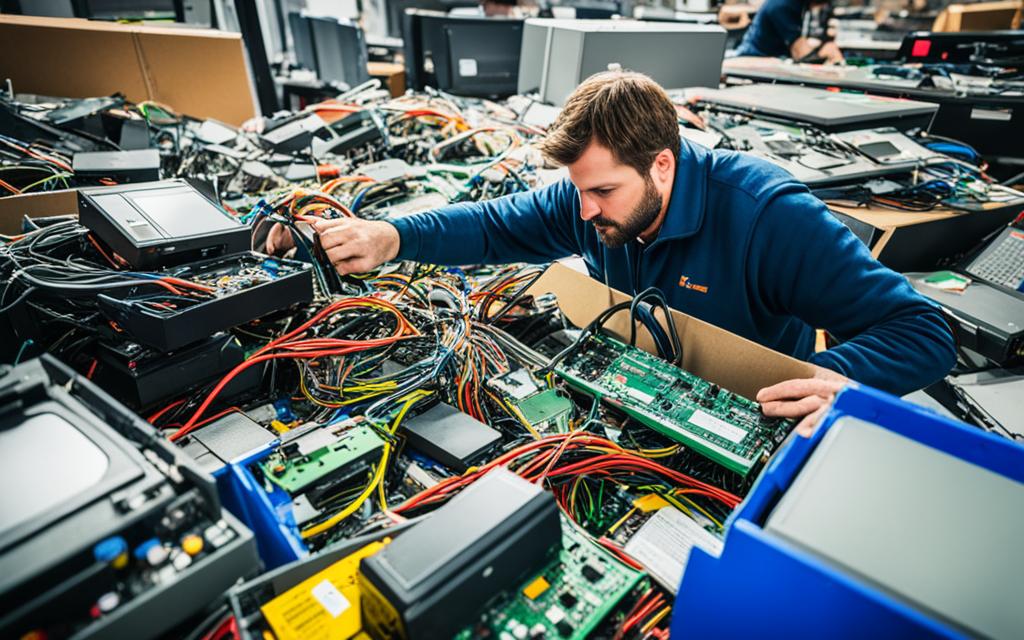Strategies for Extending the Lifecycle of IT Equipment through Recycling
Effective strategies for recycling IT equipment can help extend its lifecycle, reduce e-waste, and promote sustainability. By adopting cloud cost optimization, cloud managed services, and cloud efficiency techniques, businesses can mitigate the negative impact of e-waste.
The Global E-waste Monitor 2020 report estimates that in 2019, the world generated 53.6 million metric tons of e-waste, with only 17.4% officially documented as recycled. This staggering amount of electronic waste poses significant environmental and health hazards if not disposed of properly.
Cloud cost optimization techniques include monitoring resource usage, implementing automation, and adopting serverless architecture. These practices allow businesses to make the most of their IT resources while reducing waste and unnecessary expenditure.
Cloud managed services offer proactive monitoring, efficient resource allocation, and scalability. With expert assistance, businesses can optimize their cloud infrastructure, prevent waste, and streamline their operations.
Improving cloud efficiency involves data center consolidation, virtualization and containerization technologies, and choosing energy-efficient infrastructure. These approaches minimize energy consumption and reduce the need for physical hardware, contributing to a greener IT ecosystem.
In addition, businesses can reduce e-waste and achieve cost savings by implementing pay-as-you-go pricing models, resource pooling and sharing, and device lifecycle management strategies.
By embracing these strategies, businesses can extend the lifecycle of their IT equipment, reduce e-waste, and pave the way for a more sustainable future.
The Importance of Proper Disposal and Recycling of Electronic Equipment
Proper disposal and recycling of electronic equipment are of utmost importance to prevent significant environmental and health hazards. Electronic waste, commonly known as e-waste, contains hazardous substances such as lead, cadmium, and mercury. If not handled correctly, these toxins can contaminate our water, air, and soil, posing a threat to both the ecosystem and human health.
The Global E-waste Monitor 2020 report sheds light on the alarming statistics surrounding e-waste. Out of the 53.6 million metric tons of e-waste generated worldwide in 2019, only a mere 17% was officially documented as recycled. This inadequate recycling rate highlights the urgent need for proper disposal and recycling practices.
Recycling electronic equipment is not only essential for environmental preservation but also for the recovery of valuable materials. By recycling electronic devices, we can recover precious metals like gold, silver, and copper, reducing the reliance on raw material extraction. This not only helps conserve natural resources but also reduces the overall carbon footprint associated with the production of new electronics.
Collaborating with reliable computer recycling services is key to ensuring safe disassembly, material recovery, and responsible disposal of hazardous components. These professional service providers have the expertise to handle electronic waste effectively, minimising the potential risks and promoting sustainable practices. Additionally, by partnering with these recycling services, businesses can also generate rebates from the refurbishment of assets that still hold value.
The proper disposal and recycling of electronic equipment are crucial for protecting the environment, preserving natural resources, and safeguarding human health. By recycling our electronic devices responsibly, we can move towards a more sustainable and eco-friendly future.
Proper disposal and recycling practices play an indispensable role in mitigating the negative impact of electronic waste on our planet. By embracing these practices, businesses and individuals alike can contribute to building a cleaner and greener future for generations to come.
Cloud Efficiency Strategies for Reducing E-waste
Cloud efficiency plays a vital role in reducing e-waste associated with cloud computing. By adopting various strategies, businesses can improve cloud efficiency and contribute to a more sustainable future.
Data center consolidation is one effective strategy to consider. By consolidating servers and virtual machines within data centers, businesses can reduce energy consumption and minimize physical hardware requirements. This not only optimizes resource utilization but also helps in reducing e-waste.
Virtualization and containerization technologies also play a significant role in enhancing cloud efficiency and reducing e-waste. These technologies optimize resource utilization, allowing businesses to make the most of their existing infrastructure without the need for additional physical hardware. By leveraging virtualization and containerization, companies can reduce their energy consumption and minimize electronic waste, contributing to a more environmentally friendly approach.
In addition to adopting technology-driven strategies, it is essential to choose energy-efficient infrastructure providers. Prioritizing energy efficiency in data centers helps in further reducing e-waste. Businesses should partner with providers that demonstrate a commitment to sustainable practices and offer energy-efficient infrastructure solutions.
By implementing these cloud efficiency strategies, businesses can minimize their environmental impact, reduce energy consumption, and promote sustainability. The optimized utilization of resources and reduced need for physical hardware contribute to the reduction of e-waste. Embracing sustainable practices in cloud computing is not only beneficial for businesses’ bottom line but also for the planet.
Benefits of Cloud Managed Services in Reducing E-waste
Cloud managed services offer several benefits for businesses in reducing e-waste. Proactive monitoring and maintenance provided by managed service providers can help identify potential issues, minimize downtime, and prevent waste. These experts can also optimize cloud resource allocation by analyzing usage patterns, ensuring maximum efficiency, and reducing unnecessary waste. The scalability and flexibility of managed services enable businesses to scale their cloud resources dynamically, preventing overprovisioning and reducing e-waste. By leveraging cloud managed services, organizations can optimize their cloud infrastructure while reducing their environmental impact.
The Advantages of Cloud Managed Services in Reducing E-waste
Cloud managed services provide businesses with a range of advantages that contribute to reducing e-waste and promoting sustainability. Here are the key benefits:
- Proactive Monitoring and Maintenance: Managed service providers employ proactive monitoring and maintenance practices to identify and address potential issues. By detecting and resolving problems early on, businesses can minimize downtime and prevent unnecessary waste.
- Optimized Resource Allocation: Managed service providers analyze cloud resource usage patterns and optimize resource allocation to ensure maximum efficiency. By allocating resources based on actual needs, businesses can reduce wasteful overprovisioning and optimize resource utilization.
- Scalability and Flexibility: Cloud managed services offer scalability and flexibility, allowing businesses to dynamically scale their cloud resources up or down as needed. This prevents overprovisioning and ensures efficient resource utilization, ultimately reducing e-waste.
By leveraging cloud managed services, businesses can not only streamline their operations but also contribute to reducing e-waste and promoting environmental sustainability.
| Benefits of Cloud Managed Services in Reducing E-waste |
|---|
| Proactive monitoring and maintenance |
| Optimized resource allocation |
| Scalability and flexibility |
Conclusion
Implementing effective strategies for extending the lifecycle of IT equipment through recycling is crucial for reducing e-waste and creating a sustainable future. By adopting cloud cost optimization, cloud managed services, and cloud efficiency techniques, businesses can minimize their environmental impact, reduce energy consumption, and promote resource conservation.
Collaborating with reliable computer recycling services ensures proper disposal, material recovery, and responsible handling of hazardous materials, contributing to a cleaner and greener world. By taking these steps, businesses not only reduce their carbon footprint but also maximize the value and sustainability of their IT equipment.
To learn more about recycling IT equipment and playing a part in creating a sustainable future, you can visit server recycling in the UK. Together, we can build a better tomorrow by prioritizing IT equipment recycling, extending its lifecycle, and reducing e-waste.
FAQ
What is the importance of extending the lifecycle of IT equipment through recycling?
Extending the lifecycle of IT equipment through recycling is crucial for reducing e-waste and building a sustainable future. It helps in minimizing the environmental impact and promoting resource conservation.
How can cloud cost optimization techniques contribute to reducing e-waste?
Cloud cost optimization techniques, such as monitoring resource usage, implementing automation, and adopting serverless architecture, can help businesses minimize their environmental impact and reduce energy consumption.
What are the benefits of cloud managed services in reducing e-waste?
Cloud managed services offer proactive monitoring and maintenance, efficient resource allocation, and scalability, which can help identify potential issues, minimize downtime, and prevent waste.
Why is proper disposal and recycling of electronic equipment important?
Improper disposal of electronic equipment can pose significant environmental and health hazards. Recycling electronic equipment allows for the recovery of valuable materials while reducing the need for raw material extraction and minimizing the contamination of water, air, and soil.
What cloud efficiency strategies can businesses adopt to reduce e-waste?
Businesses can improve cloud efficiency by adopting strategies such as data center consolidation, virtualization and containerization technologies, and choosing energy-efficient infrastructure providers.
How can collaborating with computer recycling services help in responsible disposal of hazardous materials?
Collaborating with reliable computer recycling services ensures safe disassembly, material recovery, and responsible disposal of hazardous materials, while also helping businesses generate rebates from the refurbishment of assets.













